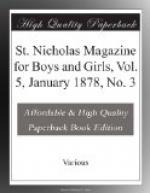SHARP-WITTED ROBINS.
Detroit, Michigan.
DEAR JACK-IN-THE-PULPIT:
Z.R.B’s anecdote, “A Congress of Birds,”
in
the July number, reminds me
of an incident of which I was an
eye-witness:
A cherry-tree grew near the house, and was yearly full of luscious cherries; but the robins scarcely allowed us to have one that did not have their monogram picked in it. One year, however, my brother determined to outwit the birds, and hung a large stuffed eagle from one of the boughs. The birds assembled on a neighboring tree and eyed the eagle sharply, while a grand consultation was held. Finally, a courageous robin darted from the tree, swooped directly under the eagle, and flew triumphantly back to tell the rest there was nothing to be feared. At once the whole flock of robins flew to the cherry-tree, and our hopes of a cherry-pie were doomed to disappointment for that year.
H.P.B.
A VERY DEAD LANGUAGE.
I once heard of a green-colored South American parrot who was more than one hundred years old. This aged fellow could speak in a real language which was known to have been used by a tribe of South American Indians who, it is supposed, petted and taught him when he was young. One by one the Indians died, until there was no one left who could understand a word of their language. The poor old bird tried hard to keep cheerful, but there were sorry times when he would mope by himself and say over some of the words of the language that had been spoken by his earliest and dearest human friends.
That was a very dead language, indeed, my dears; so dead that it is no wonder it made the old green parrot blue to speak it now and then. However, by this time it is past all power to worry anybody else, let us hope.
A PLANT THAT WALKS UPSIDE DOWN.
Shrubs, trees, Jack-in-the-Pulpits, and all such plants, grow with their roots down in the ground; but I’ve lately heard that a man called a philosopher, once wrote of a plant that grows and walks with the roots upward!
Lord Francis Bacon is the man’s name, and the plant he meant is Man. Only he wrote in Latin, I believe, and so, instead of calling Man “a plant upside down,” he called him “planta inversa.” He explained these words by saying that the brain in man, whence the nerves start, to spread like a net-work all through the body, corresponds to the roots in a plant.
If this is so, my dears, you are a kind of walking plants, only you are obliged to walk top-side down. This seems curious, but it is pleasant to think you are not so very different from a Jack-in-the-Pulpit after all.
THE SMALLEST INSECT KNOWN.
The Red Schoolhouse.




